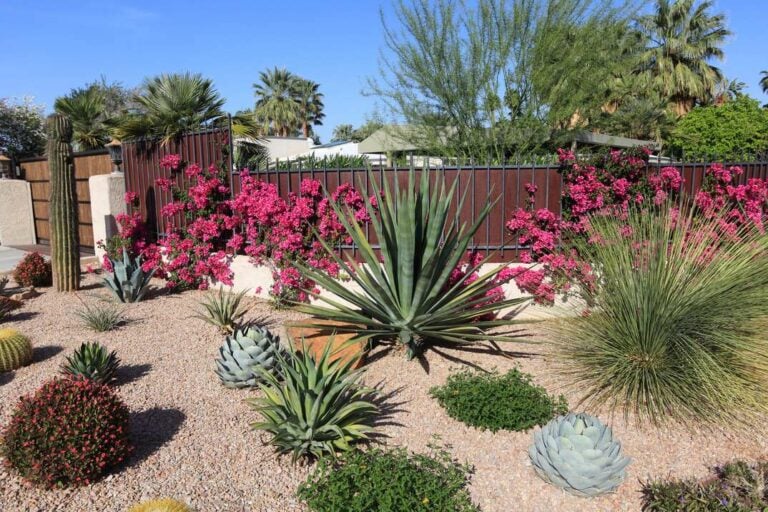Xeriscaping is a cutting-edge approach to landscaping that embodies environmental responsibility and creativity at the intersection of outdoor beauty and sustainable solutions. For homes in dry climates or areas vulnerable to drought, this innovative approach to landscaping provides a lifeline. It gives a blueprint for designing rich, colorful outdoor environments that flourish in the face of limited water resources.
Xeriscaping is a paradigm change in the way we approach landscape design because of its emphasis on native plants, water conservation, and low care. Rethinking our outdoor areas as robust, self-sustaining ecosystems that adapt and thrive in the face of environmental difficulties is more important than simply designing an aesthetically pleasing garden.
Xeriscaping has become a popular option for homeowners who want to combine beauty with sustainability as they explore methods to lessen their impact on the environment and preserve valuable resources. Homeowners may create beautiful, natural landscapes with minimal water use, low care needs, and support for nearby ecosystems by adopting the xeriscaping philosophy.
In this piece, we’ll explore the practice of xeriscaping and learn how to create a stunning, drought-tolerant landscape that looks great all year round. We’ll examine the essential ideas and techniques that define xeriscaping and provide homeowners the tools they need to design gorgeous yet ecologically conscious landscapes, from choosing drought-tolerant plants to putting in place effective irrigation systems and designing habitat gardens for local animals. Together, we will explore the life-changing possibilities of xeriscaping and learn how this cutting-edge method may support us in creating environmentally-friendly landscapes that flourish under the most trying circumstances.
Understanding Xeriscaping:
Originally developed in arid areas, xeriscaping is a landscaping style that is becoming increasingly popular due to its capacity to preserve water while preserving aesthetic appeal. Originating from the Greek word “xeros,” which means dry, the name “xeriscape” highlights the use of drought-tolerant plants, effective irrigation techniques, and improved soil to produce resilient landscapes.
Principles of Xeriscaping:
- Water Conservation: The idea of water efficiency is fundamental to xeriscaping. With xeriscapes, water consumption may be drastically decreased in comparison to typical landscapes by using drought-tolerant plant selections, effective irrigation methods like drip irrigation or soaker hoses, and water-saving strategies like mulching and rainwater collection.
- Soil Improvement: The effectiveness of xeriscaping initiatives depends on having healthy soil. Adding organic matter, such as compost or old manure, to the soil helps it retain water better, improves its structure, and encourages plants to absorb nutrients. Plants resistant to drought will remain vibrant if the soil drains well enough to avoid waterlogging and root rot.
- Native Plant Selection: In xeriscaping, selecting native and adapted plant species that are compatible with the local temperature and soil type is essential. Native plants have adapted to live in their native environments, requiring little water once established and drawing in nearby fauna such as beneficial insects and pollinators.
- Efficient Irrigation: In order to minimize evaporation and runoff, xeriscapes use water-efficient irrigation techniques to provide water directly to the root zone of plants. Specifically, drip irrigation uses less water by distributing water gradually and accurately, which encourages the establishment of deep roots in plants, making them more resilient to drought.
- Mulching: Mulching protects plant roots from temperature swings, inhibits weed development, and preserves soil moisture. All of which are vital aspects of xeriscaping. As organic mulches break down over time—such as wood chips, bark, or compost—they also enhance soil fertility.
Creating a Xeriscape:
- Assess Your Site: Assess the soil type, solar exposure, and microclimate of your site. In order to choose the best plants and xeriscape design features. When designing your environment, take into account elements like slope, drainage patterns, and existing plants.
- Design with Purpose: Make sure your xeriscape is useful as well as aesthetically pleasing. To maximize biodiversity and water efficiency, combine a range of plant heights, textures, and colors to generate visual appeal.
- Plant Wisely: Choose a varied assortment of plants that can withstand dryness. Such as low-water shrubs, succulents, native wildflowers, and decorative grasses. As you space plants in your landscaping, take into account their mature size and growth tendencies. Group plants that have comparable water requirements together.
- Implement Water-Saving Techniques: To provide water directly to the root zone of plants. Use water-efficient irrigation methods like drip irrigation or microsprinklers. Consider collecting rainwater for irrigation. Use rain barrels or cisterns, and use mulches that retain moisture to minimize evaporation and weed competition.
- Maintain Regularly: Xeriscapes are less maintenance-intensive than traditional landscapes, yet they still gain from routine care. For the whole year, maintain ideal health and vitality. By keeping an eye on soil moisture levels, pruning plants as necessary, and pulling weeds.
Sustainable Outdoor Paradises
Xeriscaping is the artful fusion of creativity, sustainability, and aesthetics in landscaping. Homeowners may build resilient landscapes that grow in harmony with nature. While limiting water consumption and care requirements by adopting the concepts of native plants, efficient design, and conservation of water.
As we draw to a close our investigation of xeriscaping. It is evident that this novel strategy has several advantages for homeowners as well as the environment. Xeriscaping is the epitome of sustainable landscaping. It not only conserves water and encourages biodiversity but also improves outdoor areas’ aesthetic appeal while utilizing fewer chemical inputs.
Gaining expertise in xeriscaping gives up a world of options for landscaping. Whether you’re dealing with a dry area or just want to take a more eco-friendly approach. The possibilities for innovation and beauty are endless. From developing lush, water-smart landscapes full of colorful wildflowers and ornamental grasses to creating brilliant desert gardens full of native succulents and cacti.
In addition to creating an outdoor oasis that pleases the senses, homeowners adopt xeriscaping ideas and practices. Also support the health and vitality of our planet. We contribute to creating a more sustainable future for future generations with every drought-tolerant plant we choose. Every drop of water we preserve, and every habitat we provide for local species.
You can create lush, water-smart outdoor paradises that are good for the environment and people alike by using the art of xeriscaping. Whether you’re starting a project in your own backyard or just looking for ideas for sustainable landscaping techniques. Allow these guidelines to direct you as you create landscapes. Those that are thriving in balance with the natural world. Hence, while also being exemplary models of sustainable living and environmental care.






